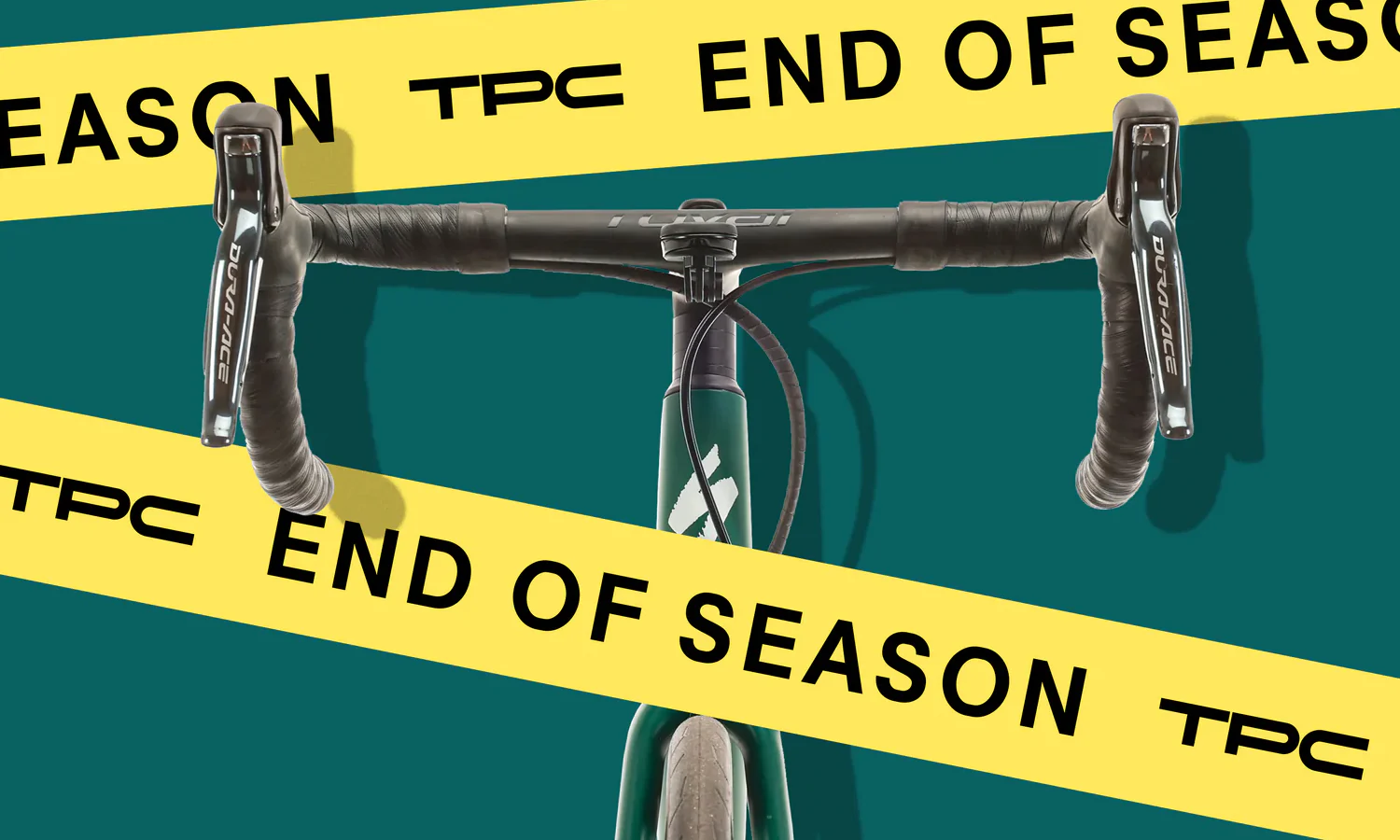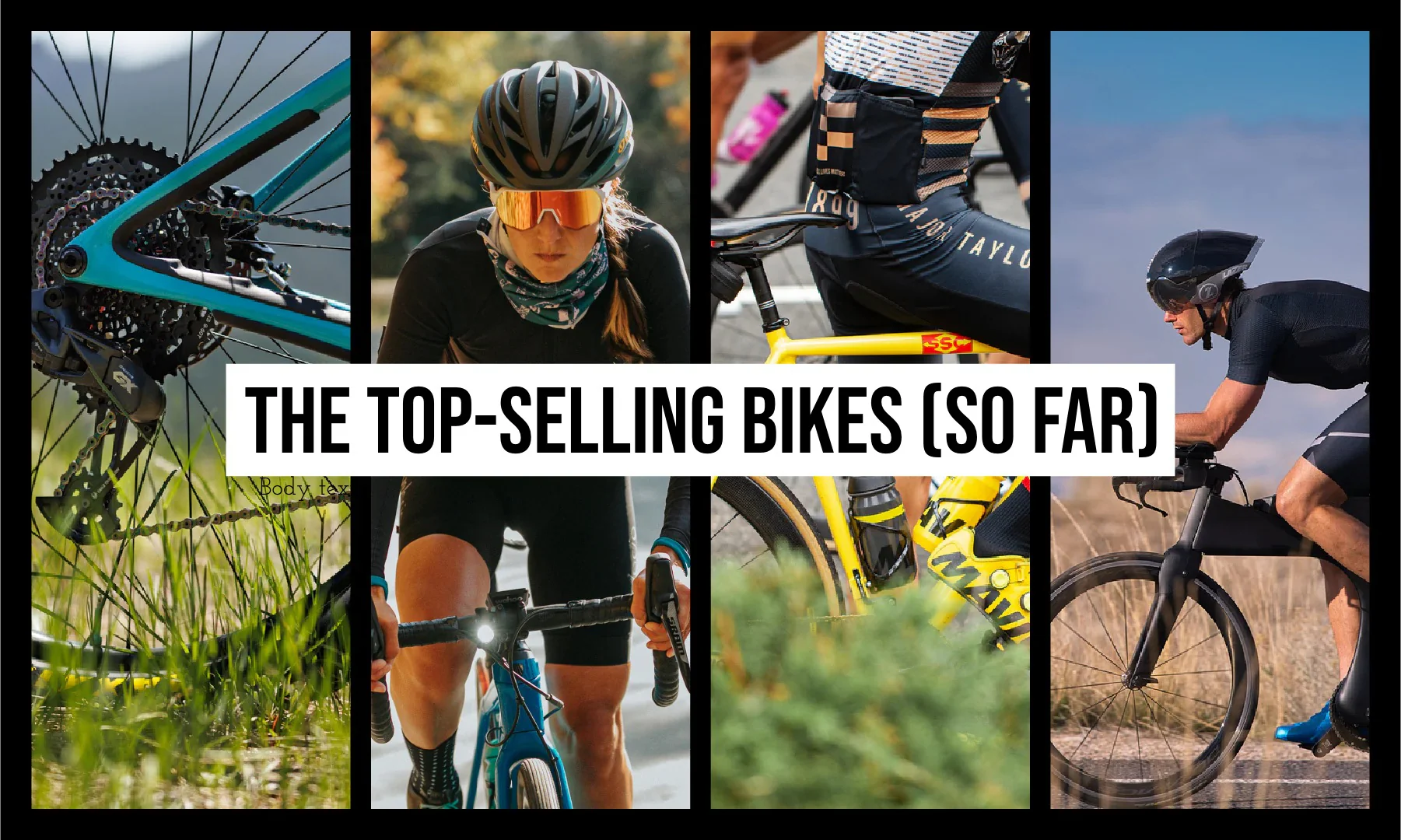You’ve probably heard this before: wind resistance is the main force cyclists have work against. This means that improving aerodynamic efficiency gives you an unquestionable speed advantage.
Watch a modern professional bike race and you’ll likely see a number of riders on the sleek and slippery aero road bikes with advanced stealth-fighter-shaped frames. (Just check out how many aero bikes won stages in this year's Tour.)
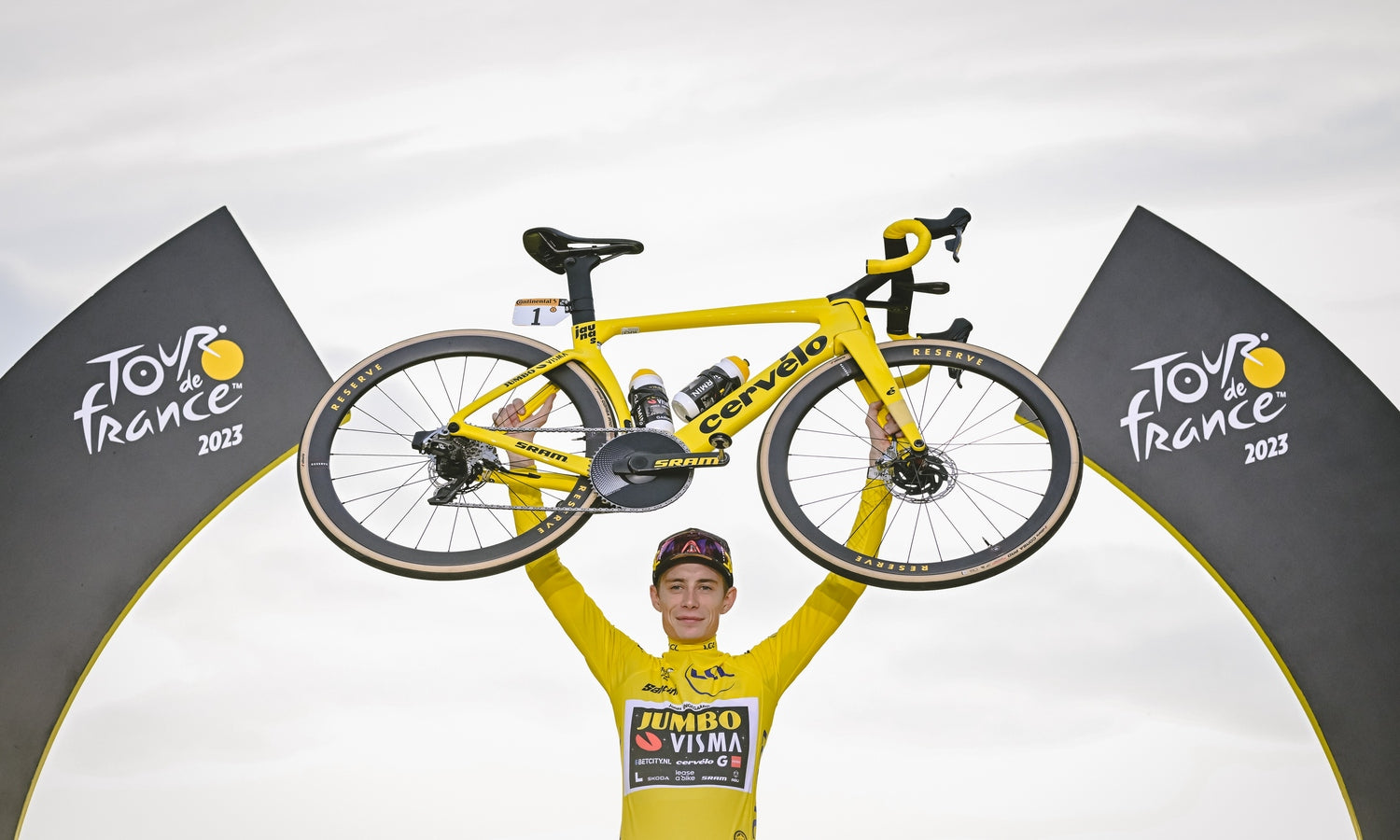 Two-time Tour de France winner, Jonas Vingegaard, chooses the aero Cervelo S5 for the majority of races. He only switches to a lightweight all-rounder on the biggest mountain stages. Photo: A.S.O./Paulin Ballet
Two-time Tour de France winner, Jonas Vingegaard, chooses the aero Cervelo S5 for the majority of races. He only switches to a lightweight all-rounder on the biggest mountain stages. Photo: A.S.O./Paulin Ballet
Engineering modern aero road bikes is an intensive, technical, and expensive process. Beyond ads and marketing, the world of aerodynamics is often mysterious and inaccessible to everyday cyclists. We don't have access to wind tunnels and testing equipment to know for sure how much difference an aero bike will make in everyday riding.
We know the pros care about aerodynamics. But are aero bikes worth it for everyday riders? Can you be frugal and make yourself more aero on your current bike? Here’s everything you need to know.
[button]Shop Aero Road Bikes[/button]
Aero vs. All-Rounder Road Bikes: The Basics
When it comes to road racing bikes, they can be broadly separated into two categories: Aero bikes and all-rounders (which some riders might refer to as "lightweight" road bikes or "climbers"). These are the types of bikes you'll see being ridden by pro racers in events like the Tour de France. Outside of race-oriented bikes, we also have endurance road bikes, but those won't be covered here.
Here are the basic differences:
|
Aero Road Bikes |
All-Rounder Road Bikes |
|
Typically heavier |
Typically lighter |
|
Deeper, more sculpted frame tubes |
Rounder or skinnier frame tubes |
|
More integrated components |
More conventional components |
|
Deeper aero wheels |
Shallower & lighter wheels |
|
Faster on flat or rolling terrain |
Faster on big climbs |
Of course, these are generalizations and there are always exceptions, but this is how most road cyclists will think about the differences between an aero bike and an all-rounder. However, many bikes might fall into a gray area between the two extremes. Many all-rounders have aerodynamic elements and some aero bikes can be fairly lightweight.
Here's a super basic way to distinguish between the two categories:
- Aero bikes prioritize aerodynamic efficiency over other qualities, especially weight.
- All-rounders try to find a more even balance weight, comfort, stiffness, and aerodynamics.
Popular aero bike models: Trek Madone, Cervelo S5, Canyon Aeroad, Cannondale SystemSix, Giant Propel, Specialized Allez Sprint, Specialized Venge (discontinued)
Popular all-rounder bike models: Specialized Tarmac, Trek Emonda, Cervelo R5, Canyon Ultimate, Cannondale SuperSix Evo, Giant TCR
In the pursuit of speed, many modern aero bikes tend to use aero gimmicks in the form of proprietary or integrated components and features to try and gain an aerodynamic edge over their competitors.
 Popular aero bikes like the Cervelo S5 (see the V-stem and front fairing) and Trek Madone (see the IsoFlow rear end and integrated cockpit) tend to use a lot of proprietary parts and integration.
Popular aero bikes like the Cervelo S5 (see the V-stem and front fairing) and Trek Madone (see the IsoFlow rear end and integrated cockpit) tend to use a lot of proprietary parts and integration.
As a result, most modern aero bikes are much more complicated to maintain and service than their all-rounder counterparts. So are aero bikes worth owning if you're a regular rider?
Well, if you care about maximizing your performance and speed, then aero road bikes are generally faster on most road terrain short of long and steep climbs (more on that in a moment). Unless you live somewhere that's especially mountainous, then you can likely benefit from riding a bike that focuses on aerodynamic efficiency.
You Don’t Need To Ride Fast To Experience Aero Benefits
World Tour pros aren’t the only riders who benefit from improved aerodynamics. Your average rider can still gain valuable speed and time. To learn more, I spoke to aero expert Mio Suzuki, Senior R&D Engineer leading aerodynamics at Specialized, who explained the testing she’s done with riders of different levels. The magic number where we start benefiting from aero gains is surprisingly low — only 13mph.
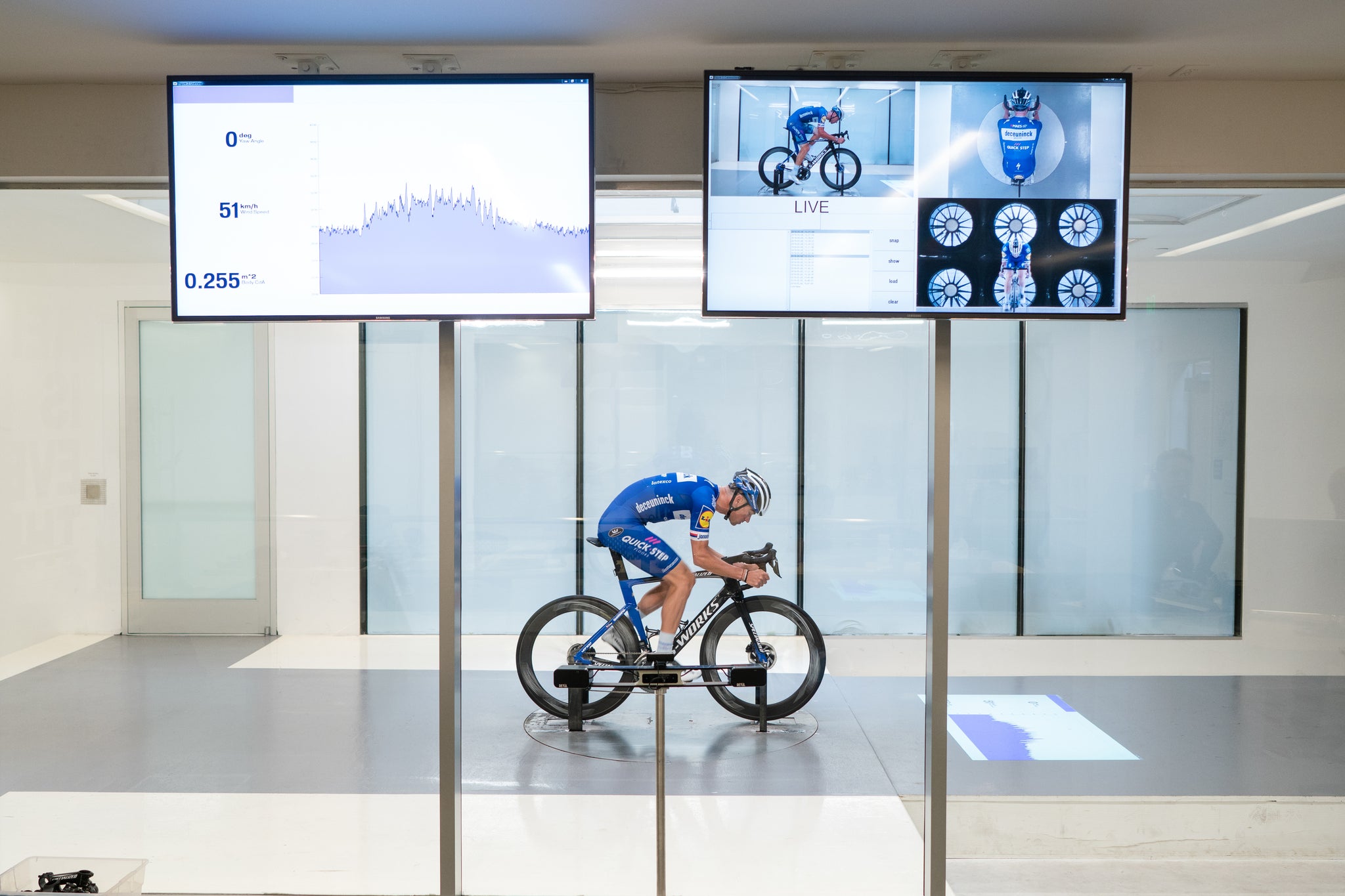 “One of the findings we’ve made is that from 13mph and up, aerodynamics will come into play pretty significantly and have a very positive effect,” Suzuki says. “That sort of speed is pretty average for a rider who’s not competitive. Obviously, for professionals averaging 20-to-30mph, aerodynamics are important. But when measuring the time difference when moving from point A to point B, you still see noticeable aero time gains at much lower speeds.”
“One of the findings we’ve made is that from 13mph and up, aerodynamics will come into play pretty significantly and have a very positive effect,” Suzuki says. “That sort of speed is pretty average for a rider who’s not competitive. Obviously, for professionals averaging 20-to-30mph, aerodynamics are important. But when measuring the time difference when moving from point A to point B, you still see noticeable aero time gains at much lower speeds.”
Suzuki explained that when looking at graphs tracking power and speed, it’s hard to tell if a bike's weight or stiffness make any appreciable difference. But it’s easier to see when an aero bike is used because of the quantifiable speed differential. According to the data Specialized has gathered, other than fitness, aerodynamics is the most important single factor that influences your speed on a road bike.
“We track data and make calculations for every category of rider to try and understand the effect of aerodynamics in a lot of different riding scenarios,” Suzuki says. “We have pretty detailed graphs and analyses of a lot of different situations. For your everyday rider, like me, who’s often riding at a 15mph average, there's no question it will definitely make you faster.”
Modern Aero Road Bikes Don’t Compromise Ride Quality
In the past, reviewers liked to criticize aero bikes for having poor ride quality (either too noodly or too stiff) due to the unique shaping of the frame tubes. But bike makers have put a lot of time, effort, and money into aero bike design and manufacturing to make them feel and ride like non-aero bikes.
 "El Tractor" Tim Declercq had no problem riding his aero Venge on the cobbles.
"El Tractor" Tim Declercq had no problem riding his aero Venge on the cobbles.
“A lot of manufacturers, including Specialized, are getting smarter about how to construct aero bikes,” Suzuki explains. “It’s definitely a design goal to make an aero bike ride like a traditional round-tubed bike.”
Carbon technology has progressed to the point that manufacturers can produce bikes of nearly any shape that exhibit the classic traits of lateral stiffness and vertical compliance. By controlling the carbon lay-up, the possibilities for precisely controlling ride quality are near limitless. When buying aero bikes made in the last five-to-ten years, riders should have few if any concerns about ride quality.
Even with aluminum bikes, clever hydroforming and welding now allow manufacturers to add stiffness to key points like the bottom bracket and compliance to areas like the seat stays.
“Compared to 10 years ago, aero bikes have evolved quite a bit. They don’t necessarily have the exact same ride feel,” Suzuki says. “But our engineering and manufacturing techniques make it so that aero bikes that too stiff or too 'noodly,' as you say, aren’t really an issue anymore.”
Aero Bikes Are Heavier, but They Aren't Pigs
Weight is a big deal for riders tackling climbs, and aero bikes generally weigh more than their non-aero counterparts because more material is needed to create aero-shaped frames.
However, advances in manufacturing have brought modern aero bikes a lot closer to all-rounder road bikes. For example, let’s compare the two Cervelo road bikes that have recently been dominating Grand Tours like the Tour de France — the 2023 Cervelo S5 (left) and a 2023 Cervelo R5 (right). I pulled two from our inventory that are the same size, and with the same drivetrain. They are using different wheels and tires, but based on claimed weights that will only account for 100-200 grams.
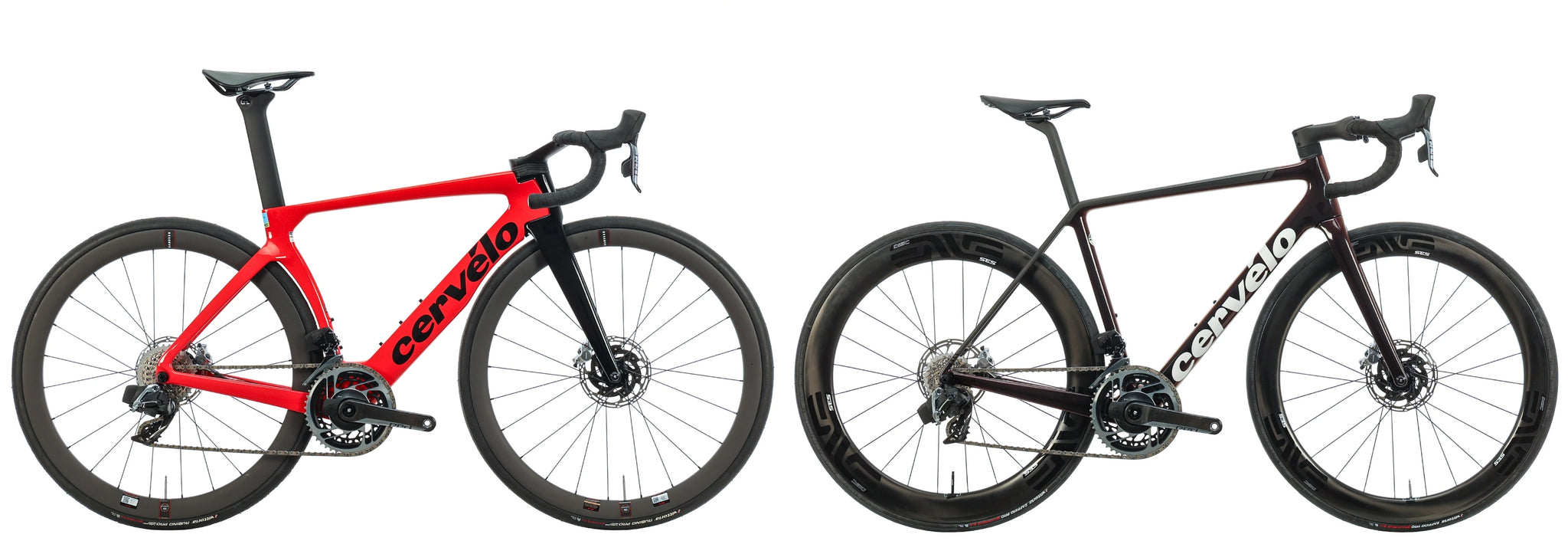 The S5 weighs 17 lbs 9 oz while the R5 weighs 16 lbs 5 oz. Okay, yes, one bike is over a pound lighter. That might seem like a lot, but the overall aero benefits can still outweigh the benefits of losing a pound of weight.
The S5 weighs 17 lbs 9 oz while the R5 weighs 16 lbs 5 oz. Okay, yes, one bike is over a pound lighter. That might seem like a lot, but the overall aero benefits can still outweigh the benefits of losing a pound of weight.
Aerodynamics still come into play on rolling and uphill terrain. Suzuki points out that the 13mph speed where aerodynamics make a positive difference is mainly quoted for flat terrain, but it’s applicable to climbing as well. The wind resistance at 13mph is the same going uphill or down. Less wind resistance will increase your speed uphill. Only on very steep gradients where your speed drops into the low single digits are you moving slow enough for weight to be a bigger factor.
Some tech articles found online will try to list specific gradients where aerodynamics are no longer a factor (e.g., at an 8%+ grade, weight will matter more for average riders). This may have some basis in fact, but Suzuki is hesitant to make specific claims like this.
“Rider weight, gradient, and a bunch of other variables all factor into climbing speed,” Suzuki says. “Because of that, there’s no way to say, universally, that there’s a single point where bike weight gains will be greater than aero gains.”
What advice can you take from this? Well, weight should only be a major concern if your primary focus is climbing on very slow and steep climbs. For all the other times when the gradient and speed are more variable, aero bikes will net greater speed advantages. Both Suzuki and I would likely choose an aero bike over a non-aero bike for our everyday riding in the foothills of California and Colorado.
For me, 17 pound bikes are still very light. However, one thing to consider is that all-rounders like the R5 have the potential to get MUCH lighter with a swap shallower and lighter wheels. You could add shallow wheels to the S5 too, but that kind of defeats the purpose of choosing an aero frame in the first place.
If you're a weight weenie, an aero bike will likely never be the right bike for you. But consider that the rider makes up the far larger percentage of the overall weight of the rider and bike combo. A single pound really only matters to riders who exist at the extremes of weight or performance. (To learn more about the effects of bike weight, check out our Does Bike Weight Matter article.)
[newsletter]
Aluminum Bikes Can Be Aero Too
 The latest Cannondale CAAD13 follows the lead of the Allez Sprint, creating an aerodynamic frame out of hydroformed aluminum to reduce cost. Photo courtesy of Cannondale.
The latest Cannondale CAAD13 follows the lead of the Allez Sprint, creating an aerodynamic frame out of hydroformed aluminum to reduce cost. Photo courtesy of Cannondale.
Aero bikes aren’t always synonymous with high-end carbon dream machines. The Specialized Allez Sprint is one of the most popular road bikes for competitive road racers because it combines a robust and budget-friendly aluminum frame with aerodynamic efficiency that surpasses the first generation Venge. With the latest generation CAAD13, Cannondale has mimicked the design of its flagship SuperSix Evo race bike and constructed the aluminum CAAD13 with slippery, truncated airfoil tubes.
[product-block handle="2021-cannondale-caad13-disc-force-etap-axs-m"/]
The belief that carbon bikes are more aero than aluminum bikes may come from the reputation carbon has for being easy to manipulate. It can be manufactured into any shape an engineer can dream up, opening up more aero possibilities. But bikes like Allez Sprint and the CAAD13 have shown that more traditional bike materials can still be made competitive.
“In general I’d say it’s easier to make an aero carbon bike because of the shaping. But that doesn’t make it more aero,” Suzuki says. “Aluminum manufacturing technology has evolved a lot. If an aluminum frame can be made with an aero cross-section at the key points then I would say an aluminum bike could be just as aero or more. It all comes down to design. The Allez Sprint shows that.”
It’s clear that budget aluminum aero bikes are possible. Hopefully, as aero becomes more mainstream, a bigger selection of budget aero bike will be available to satisfy more riders. For now, though, if you can't get your hands on a new Allez Sprint or CAAD13, the used market has plenty of aero options to choose from.
[button]Shop Aluminum Road Bikes[/button]
However, Aerodynamics Are Still a Bit of a Black Box
Regular consumers can’t test their bike's aerodynamics because we don’t have access to wind tunnels or the necessary instruments. Unlike other metrics like weight, it’s not a simple as putting a bike on the scale. So are we reliant on manufacturer’s claims and magazine tests?
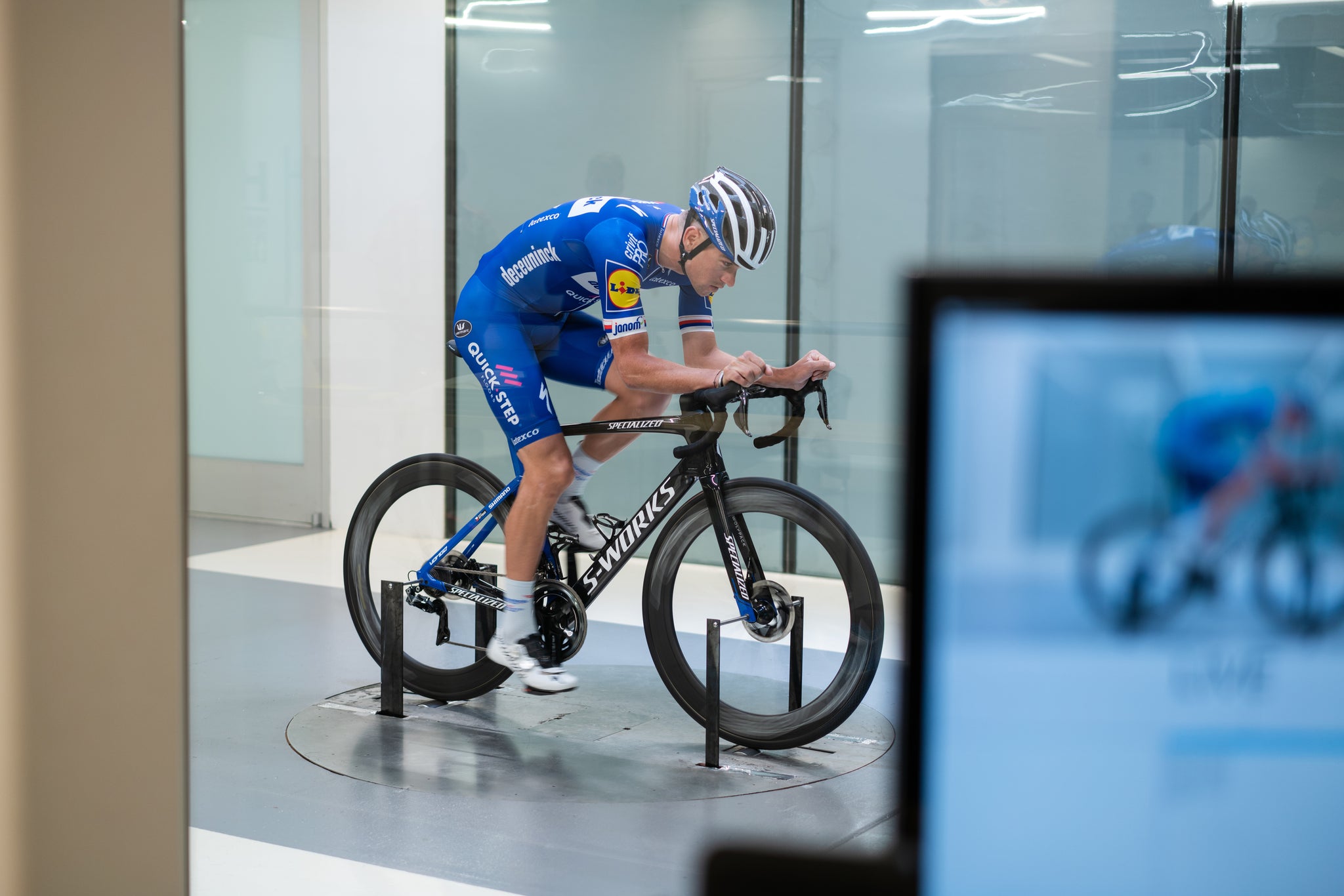 “I’ve done a lot of aerodynamic tests,” Suzuki says. “Knowing all the care we place into what we measure and how we measure things, I would like to say that the numbers and performance I can put out are trustworthy. As an engineer, I want true information.
“I’ve done a lot of aerodynamic tests,” Suzuki says. “Knowing all the care we place into what we measure and how we measure things, I would like to say that the numbers and performance I can put out are trustworthy. As an engineer, I want true information.
“How is everybody else doing it? I can’t say for sure. I like to think everybody else is providing accurate and honest info. Specialized is lucky because we own our facility. That means we can do as much wind tunnel testing as we want. If you don’t own a wind tunnel, then you have to go somewhere else and rent time. You pay per hour for usage of the tunnel so you have to carefully prioritize what to test and how to stay in budget. That might restrict the number of bikes or configurations they’re able to test.
“This is why you don’t see people and journalists just gather up 100 bikes to go compare in a tunnel. I’ve seen magazine tests and their results and they try to do their due diligence to compare bikes in a fair way. I’ve seen good tests and I’ve also seen questionable results. The questionable part being the protocols they follow.”
Unfortunately, we don’t live in a world where we have an easy way to test and compare bikes for ourselves. Most cycling publications provide nothing more than riding impressions for aero bikes. You could do some form of home testing with a flat road and a timer, but Suzuki warns that the results will be very subpar. It’s unlikely that you’ll extract meaningful data for the minute differences between two frames. The wind tunnel is the only precise and reliable tool.
If this concerns you, then consider that reputable aero-focused manufacturers, such as Specialized, Trek, Cannondale, Giant, and Cervelo, sponsor pro teams at the highest level of racing and invest significant time in the wind tunnel. It’s in their best interest to actually make competitive bikes. If you want something effective, then looking at brands that actively discuss and showcase their wind tunnel testing may be prudent. Until a magic home aero test gets invented, that's the best we got!
You Can Improve Your Current Bike With the Right Aero Upgrades
If you don’t want to purchase a new aero road bike, but you want the improve the aerodynamics of your current set-up, there are three key components to consider upgrading — your wheels, handlebars, and helmet.
 Photo courtesy of Zipp Speed Weaponry
Photo courtesy of Zipp Speed Weaponry
“Definitely wheels,” Suzuki says. She emphasizes their importance. “Aero wheels are a great, great, great investment. They are what contact the air first and everything comes behind them. With wheels too, I would highly recommend doing research because just because something is deep doesn’t mean it’s the best wheel.”
Just like with aero frames, some brands put more effort into wind tunnel testing than others. Zipp and ENVE are great examples of reputable wheel manufacturers that prove their wheels out in the wind tunnel. There are even many budget options with extensive engineering and testing behind them.
Because handlebars are another leading edge of the bike, aero handlebars can also make a significant improvement in your efficiency. Cervelo has done wind tunnel testing that has shown that handlebars contribute up to 30% of a bike’s overall drag at zero degrees of yaw.
Narrower bars are also a popular option. Narrowing your arm position will reduce your frontal area, but more importantly, it will also affect how air flows over your legs. As you pedal your legs produce turbulence, so narrower bars that move your arms more in front of your legs can reduce the resulting drag.
Aero helmets began gaining popularity around the same time as dedicated aero bikes. In 2011, the same year the Venge was released, Mark Cavendish won the 2011 World Championship road race wearing an adapted Specialized aero road helmet with its vents covered. Aero helmets have since been adopted by the peloton and regular riders. Many aero helmets sacrifice very little in terms of ventilation for their aero performance so they are a convenient way to get an extra edge.
[button]Shop Road Wheels[/button]
A Good Bike Fit and Riding Position Makes You More Aerodynamic
If you're on the fence about aero bikes, then consider getting a bike fit instead. When discussing wheels, Suzuki was quick to bring up riding position and bike fit. According to her, they are as important to your performance as aerodynamics.
“If I were to put it all in order,” she says, “I think wheels and bike fit would be my two top things. Bike fit is really an underrated secret. In terms of aerodynamics, the rider position affects efficiency quite a bit. We do a lot of testing, particularly with professional athletes, in the wind tunnel. We’ll have their hands on the hoods as a baseline posture. Then we have them hold the drops so their back angle decreases into a bit more aggressive position. We have seen as much as a 10-20 watt difference between hands on the hoods versus in the drops. That’s super-significant."
Getting as low as possible on your bike has a very positive effect on your aerodynamic efficiency. The less your body is exposed to the wind, the less wind resistance you have to fight against. Suzuki warns, however, that this isn’t a prescription to slam your cockpit as low as possible.
“You might be able to get into a perfect, aggressive position, where your back angle is low and you’re out of the wind,” she says. “But what if you can only hold it for five seconds. If it’s not sustainable for two hours, or whatever the entire duration of your ride is, then it’s meaningless."
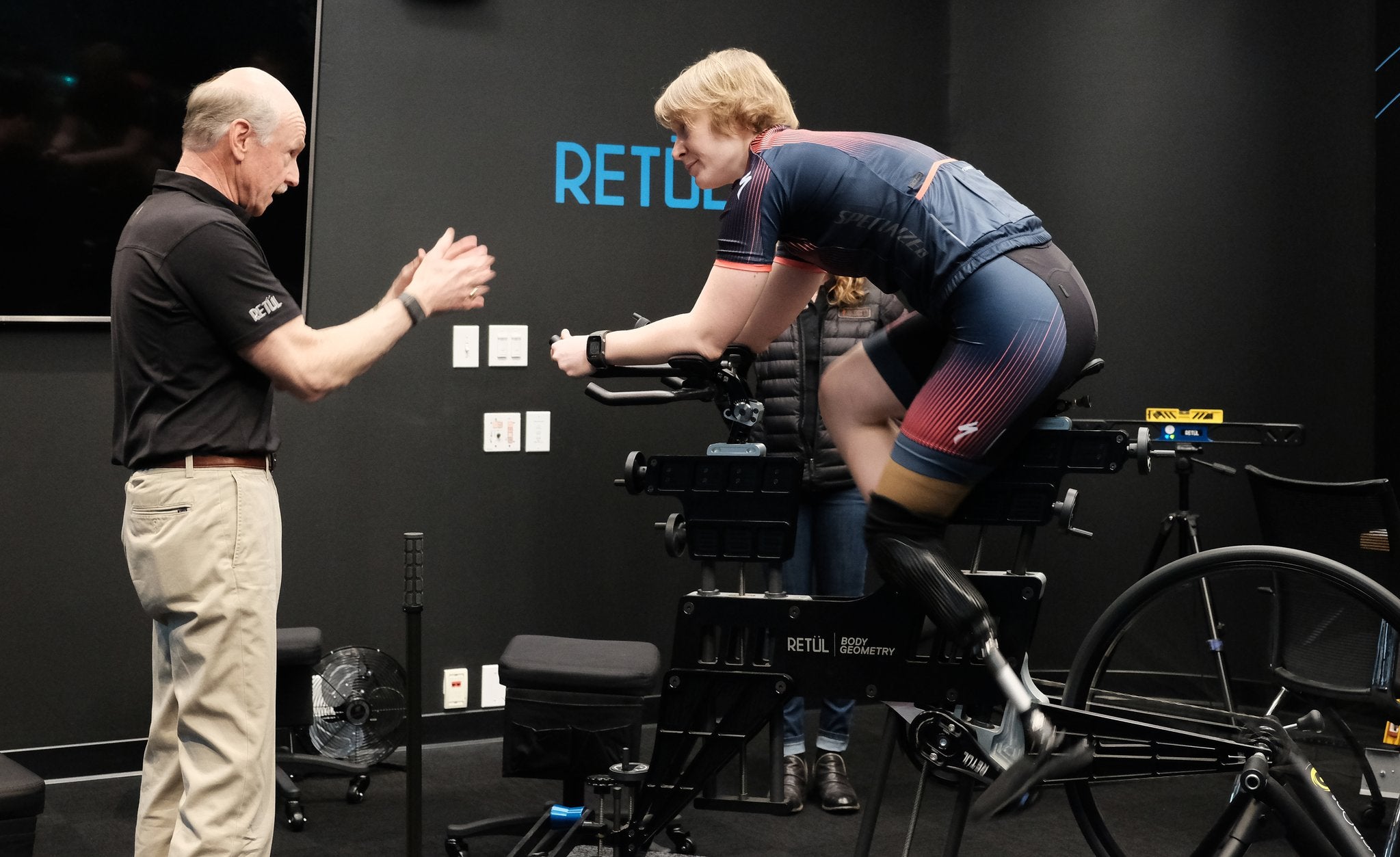 Andy Pruitt fitting a rider. | Photo courtesy of Retül
Andy Pruitt fitting a rider. | Photo courtesy of Retül
Instead, it’s better to get properly fit into the lowest sustainable position to maximize both efficiency and power. Andy Pruitt, one of the world’s foremost cycling fit experts, echoed this sentiment when I spoke with him last year. Pruitt is the founder of the CU Sports Medicine and Performance Center and has worked extensively with numerous pro riders and teams dialing in their bike fits.
“Rarely is the most aerodynamic position sustainable,” Pruitt says. “So a rider’s position will end up having to creep upward and get more comfortable to be more sustainable. Ultimately, if you’re more comfortable, you’re going to be able to go faster and harder for longer, rather than fighting to stay in some aerodynamic position.
“In some cases, bringing the handlebars up a bit actually can allow you to relax your elbows, which is not only more comfortable, but it can allow you to get more aero. A great example is pro rider Lars Bak. In his case, raising the handlebars two centimeters actually lowered his back angle four centimeters because he could relax into the front end of the bike.”
Suzuki also says that riders don’t need to worry too much about wasting the benefits of an aero bike by riding in a more upright and comfortable position.
“It doesn’t completely negate the aerodynamics of the bike,” she says. “The leading edge of an aero bike still offers a lot of benefits, particularly if it has aero wheels too.”
This is another strong argument in favor of aero bikes. If you aren’t capable of adopting an aggressive, low position, an aero bike can act as an equalizer to help you get back some of the speed you may have lost.
[button]Shop Aero Road Bikes[/button]
Photos courtesy of Specialized.


